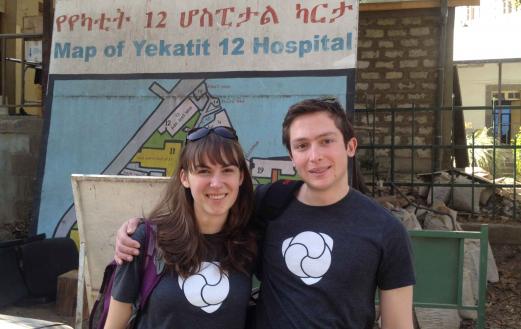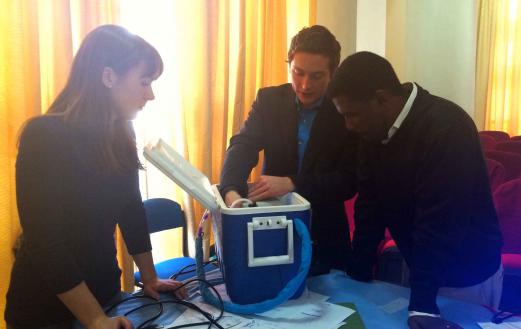PremieBreathe Team Visits Ethiopia to Test Low-Cost Respirator

Not all infant respirators are created equal.
For example, most Humidified High Flow Nasal Cannulas (HHFNC) — a type of infant respirator that can help prevent birth asphyxia, respiratory insufficiency, and complications stemming from preterm birth — cost upwards of $5,000, a prohibitive expense for medical centers in the developing world, where more than a million infants die each year from these diseases. In response, a group of current and former Yale University students has created PremieBreathe, an HHFNC that can be produced for less than $500.

Over winter break, team members Katy Chan (’15) and Jordan Sabin (’16) spent six days learning how the PremieBreathe device could be helpful to a wide range of healthcare facilities in Ethiopia, including a health center, a general hospital, and a specialized hospital. “The Ethiopian Ministry of Health has made improving infant and mother care its top priority,” said Sabin. “However, the price tag of commercial HHFNC devices means that their promise to resolve health challenges in the developing world goes largely unfulfilled. We want to change that.”
The trip centered on collecting feedback from local doctors and staff — including one of the only three neonatologists in Ethiopia — who would actually use the device. Although the main design challenges had been addressed in the team’s work at Yale, further refinements required a better understanding of conditions in low-resource nations, such as the prevalence of oxygen and the reliability of the electrical grid.
“Despite the rapid modernization of the country,” said Sabin, “we found that blackouts remain a common occurrence in rural areas of the country — though the Ministry of Health is also swiftly increasing the number of hospitals with back-up generators. Adding a battery backup system means that even healthcare facilities without a generator can rely on it, but is that worth raising the price of the device for everyone? We’ll have to continue debating that design change. On the other hand, we found that oxygen has become widely available in the past few years, so including it in our next prototype makes a lot of sense.”

Chan and Sabin also discovered on their trip that many of the country’s neonatal units have limited space for medical devices and heard from clinicians how impediments in the medical equipments supply chain prevent repairs to many extremely technical devices, making them unusable. To address these constraints, the team hopes to reduce the spatial footprint of their device while also simplifying the electronics and incorporating a higher number of easily replaced parts.
“We are committed to the continued advancement of the project all the way to deployment,” said Sabin. “And to get there, we plan to make PremieBreathe as reliable, user-friendly, and sustainable as possible.”
Begun last spring as a senior project for mechanical engineering and global affairs double major Charles Stone, the PremieBreathe device pushes air through a humidification chamber and into heated tubing, resulting in high flows of warm humid air that can aid infants in respiratory distress. From the beginning, Stone worked with Shirin Ahmed, a Yale alumna who now manages interdisciplinary global health projects for Yale’s Global Health Leadership Institute(GHLI). As the project developed, GHLI funding enabled two new members Chan, a biomedical engineering major, and Sabin, a mechanical engineering and economics double major, to join Stone and Ahmed’s team.
“The GHLI has been involved with the project since it’s inception,” said Sabin. “Their support has gotten us to where we are today.”
Further spurred on by a summer fellowship in the Center for Engineering Innovation & Design, the four of them have continued refining their prototype under the mentorship of Anjelica Gonzalez, the Donna L. Dubinsky Assistant Professor of Biomedical Engineering, and senior research scientist Larry Wilen, with additional advising from Dr. Lei Chen, an associate professor of pediatric medicine at the Yale School of Medicine and Director of Pediatric Emergency Medicine Research at Yale-New Haven Hospital.

